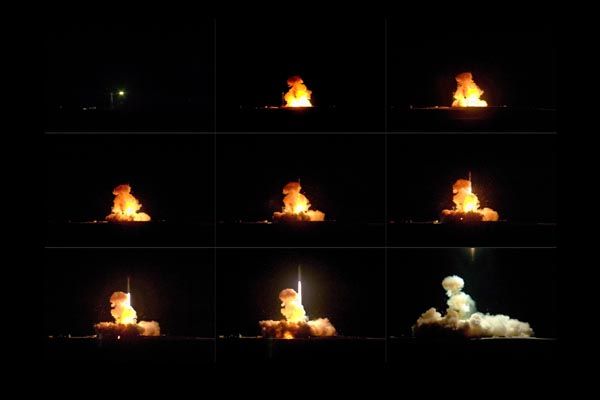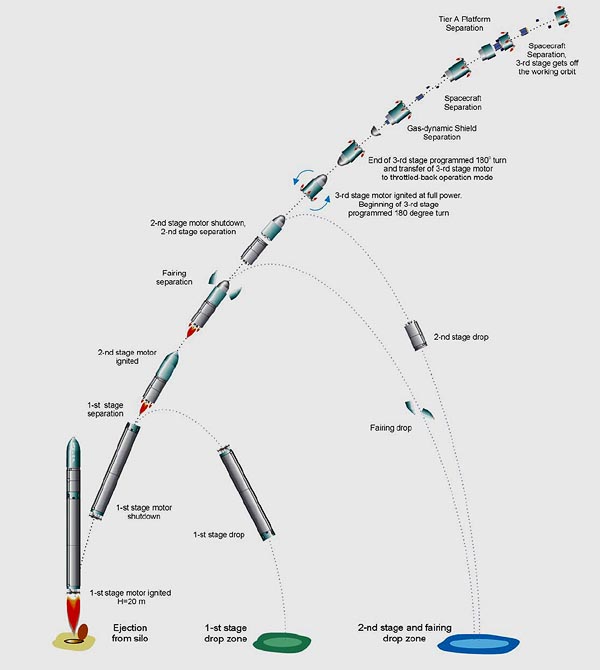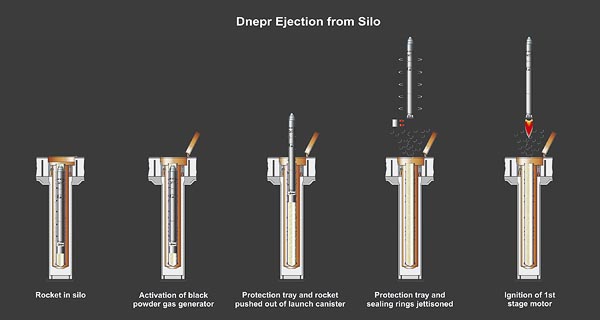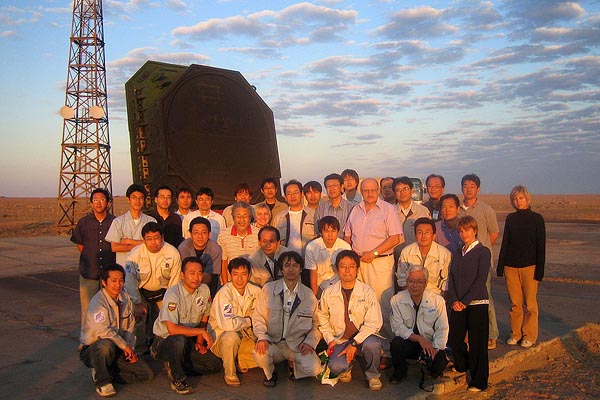Dnepr Launch VehicleDnepr Launch, Site 109, Baikonur2005-08 (C) Kosmotras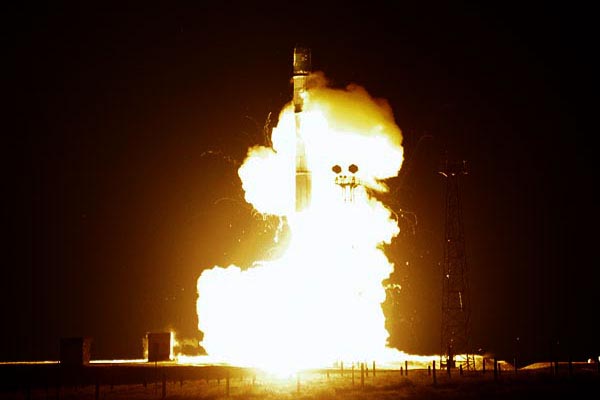
Dnepr Launch Vehicle(C) Kosmotras Payload Envelope(C) Kosmotras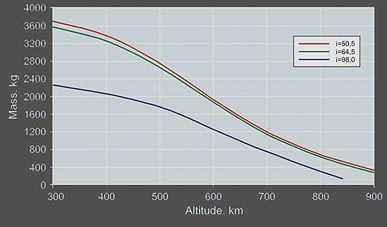 Performance Curve to Circular Orbit(C) Kosmotras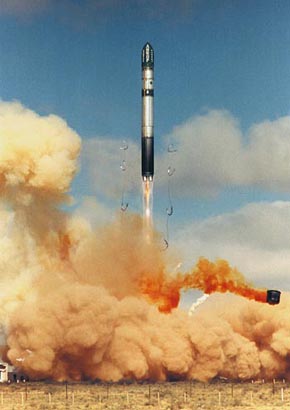  Dnepr Launch, Site 109, Baikonur(C) Kosmotras |
Dnepris a satellite launch vehicle converted from a Russian SS18 liquid-fuelled strategic missile. Dnepr has a three stage The 3rd stage is a modified standard SS18 3rd stage equipped with a liquid propellant, two-mode propulsion unit that operates based on a “drag” scheme. Space Head Module (SHM) is attached to the third stage upper end. SHM consists of a spacecraft, intermediate section, adapter, either gasdynamic shield , or Encapsulated Payload Module, protective membrane and SS18’s standard fairing.Dnepr is designed for expedient, high-accuracy injection of various single or multiple spacecraft weighing up to 3.7 tons into low-earth orbits inclined 50.5, 64.5, or 98 degrees.
|
||||||||||||||||||||||||||||||||||||||||||||||||||||||||||
Space Museum |
Energia |
Zvezda |
Korolev |
Dnepropetrovsk |
Russia |
Moscow |
St. Petersburg |
Zheleznogorsk |
Yasny |
Baikonur |
Ukraine |
Kiev |
Dnepropetrovsk |
Odessa |
Eupatoria |
Japan |
Tokyo |
Yokohama |
Kyoto |
Kamakura |
Nikko |
Himeji |
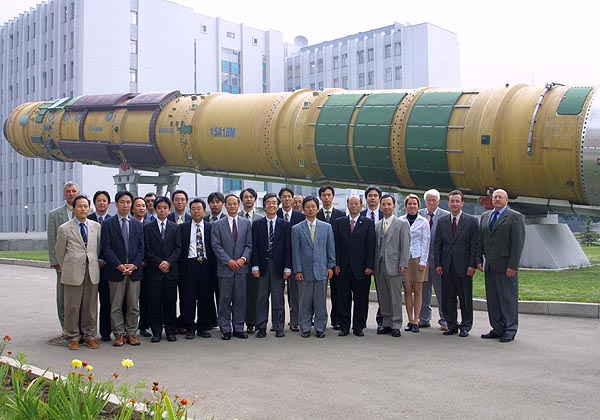

Kick-off Meeting at Yuzhnoye to Launch JAXA OICETS / INDEX Satellites
Special thanks to JAXA, 2004-09 (C) Yuzhnoye
Typical Satellite Launch Campaign Schedule of Dnepr Launch Vehicle
(C) Kosmotras
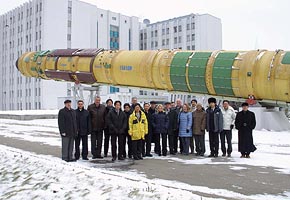
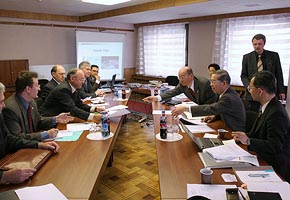
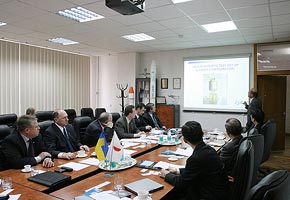
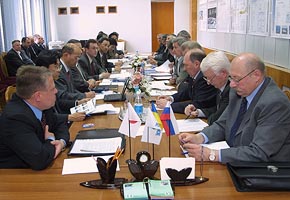
Top Management Meeting at Federal Space Agency of Russia
2005-04 (C) Seiji Yoshimoto
Critical Design Review Meeting at Yuzhnoye
Special thanks to JAXA, 2005-01 (C) Yuzhnoye
Top Management Meeting at Yuzhnoye
2005-04 (C) Yuzhnoye
Top Management Meeting at National Space Agency of Ukraine
2005-04 (C) Seiji Yoshimoto
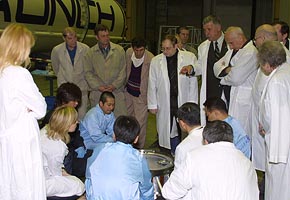
Fit Check at Yuzhnoye
2005-04 (C) Yuzhnoye
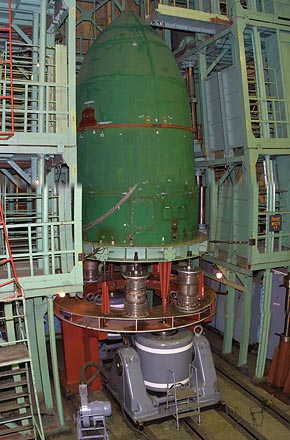
Qualification Test of Space Head Module including Satellite Mechanical Models at Yuzhnoye
2005-05 (C) Yuzhnoye
Satellite Launch Project
starts by signing a launch contract between a customer and a launch service provider.
Several project meetings will be held to discuss technical interfaces and project implementation including:.
-
Kick-off Meeting
-
Preliminary Design Review
-
Critical Design Review
-
Fit Check
-
Payload Ground Qualification Test
( combined test)
Satellite launch campaign usually takes 18 months from the start of the feasibility study or 15 months after the contract signing.
To verify the spacecraft and Dnepr launch vehicle integration and to confirm their mechanical and electrical interfaces, a ground qualification test program may be provided including:
-
spacecraft fit-check,
-
vibration test of spacecraft and SHM structure,
-
separation system test
Those qualification tests are performed at Yuzhnoye facilities with participation of spacecraft specialists.
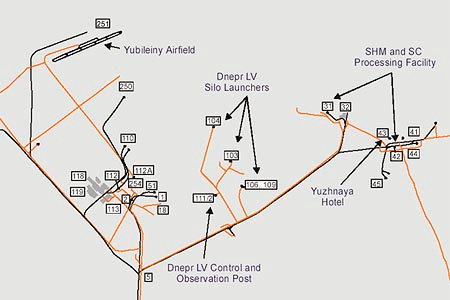
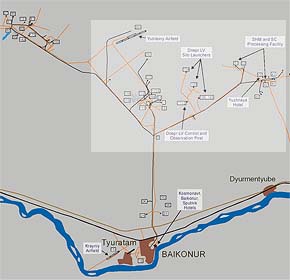
Baikonur Cosmodrome Overall Area
(C) Kosmotras
Baikonur Cosmodrome Major Area used for Dnepr Launch Campaign
(C) Kosmotras
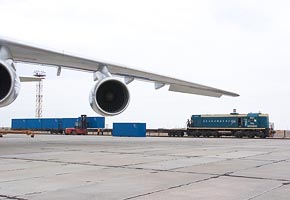
Container Off-loading at Yubileiny Airfield, Baikonur
2005-06 (C) Kosmotras
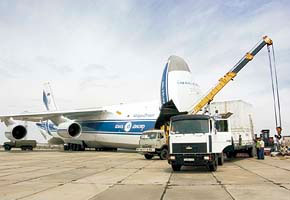
Container Transportation by Rail from Yubileiny Airfield, Baikonur
2005-06 (C) Seiji Yoshimoto
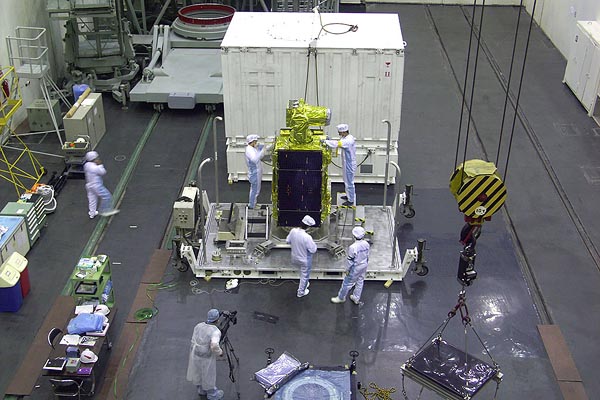
OICETS Satellite in Site 31, Baikonur
Special thanks to JAXA, (C) Kosmotras,
Baikonur
(C) Kosmotras

Integration of Space Head Module to Dnepr Launch Vehicle at Silo, site 109, Baikonur
(C) Kosmotras
Transportation of Processed Space Head Module from Site 31, Baikonur
(C) Kosmotras


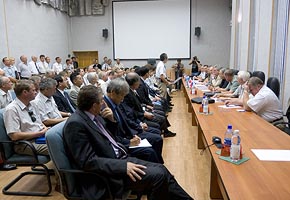
Flight Readiness Review, Baikonur
2005-06 (C) Seiji Yoshimoto
Before Integration of OICETS / INDEX Satellites into Space Head Module, Site31, Baikonur
Special thanks to JAXA, (C) Kosmotras
.jpg)
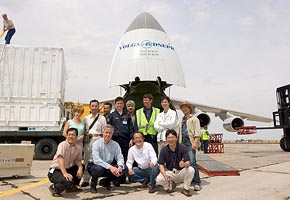
Transportation to Yubileiny Airfield, Baikonur
2005-06 (C) Seiji Yoshimoto
Containers with the satellite and its GSE arrive in Baikonur Cosmodrome by air or by rail. Containers are off-loaded by lifting gear of the airplane, road cranes or forklifts using pull ropes, cross-arms, pallets and other Customer's devices. Arrived containers will be delivered to the Satellite processing facility by road or rail.
Facilities used for Dnepr launch campaign in Baikonur is located in eastern half of the Cosmodrome. Satellites and Ground Support Equipment (GSE) arrive at Yubileiny Airfield, then transported to the satellite processing facility in site 31 or 42. The launch is from a silo at site 109.
For more details of Baikonur Cosmodrome, please refer to: Baikonur Cosmodrome
Assembled and processed Space Head Module (SHM) is loaded into the transporter-erector and delivered to the launch complex. During the transportation, the temperature and humidity conditions around the spacecraft are maintained by the transporter-erector air conditioning system.
Upon arrival at the silo, the Space Head Module, by the transporter erector, is mated with the launch vehicle installed inside the silo. Electrical checks of the launch vehicle with Space Head Module, data analysis, final launch preparation operations are performed.

A total of eight interpreters supported the communications among Russian, Ukrainian and Japanese specialists through the satellite launch program.
(C) Kosmotras
Dnepr Launch Vehicle is launched from Baikonur Cosmodrome in Kazakhstan or Yasny Launch Base in Russia.
Dnepr is launched from a silo. Dnepr is steam ejected from its transport and launch canister to a height of approximately 20 meters above the ground by activation of the black powder gas generator. The first stage engines are ignited upon the rocket ejection from the launch canister.
Separation of stages and fairing follows the proven SS18 procedures. Spacecraft is separated from the third stage by the third stage taking away from the spacecraft by means of throttled-back operation of its motor. Prior to the spacecraft separation, the gas dynamic shield is jettisoned.
For more details of Dnepr Launch Vehicle, please visit Kosmotras home page.

Black powder gas generator (left) and a tray protecting the base (right) of the of SS17 missile. Larger size generator and tray are used for SS18/Dnepr Launch Vehicle.
2006-07 (C) Seiji Yoshimoto
The gas generator fires to pressurize the canister, pushing the tray and missile up out of the silo. After exiting the silo, the tray is jettisoned sideways.The first stage main engines ignite immediately after the tray moves aside.
Satellite launch was very dramatic, especially for the project members who had worked hard for the international space program. The OICETS and INDEX satellites were successfully injected into their planned orbits very precisely. It was an end of one drama of Rocket specialists but is a start of a new drama of satellite specialists.
The intensive international cooperation to launch Japanese satellites by peaceful use of a Russian SS18 missile was successfully completed. The cooperation among Russian, Ukrainian, and Japanese specialists during the launch program was so fruitful and enthusiastic that several members volunteered to establish a international Non Profit Organization, "NPO InterCoS" in order to promote international peaceful cooperation in space.

Piggyback Launch Space Available |
Launch in 3rd quarter of 2009 by Dnepr Launch Vehicle. Please contact ISC Kosmotras for details. ISC KOSMOTRAS
|
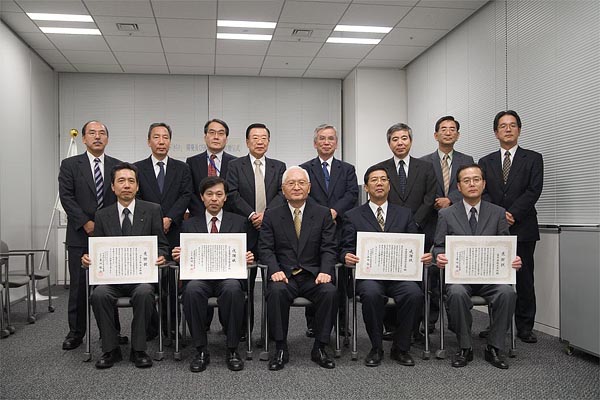
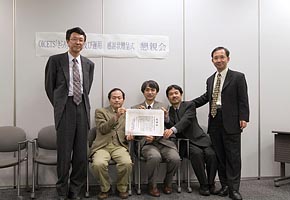
Remarkable Achievements of OICETS
JAXA Testimonialized Japanese Space Industry that contributed to OICETS
Special thanks to JAXA, 2006-11 (C) Seiji Yoshimoto
NTSpace Managers of OICETS Project
2006-11 (C) Seiji Yoshimoto
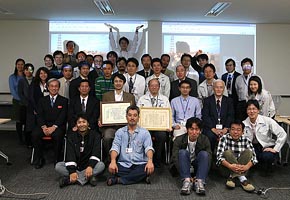
OICETS Project Members
2006-10 (C) Seiji Yoshimoto
OICETS / INDEX Launch News Release |
OICETS Home Page |
OICETS Home Page Backnumber |
INDEX Home Page (Japanese) |
Within one year after the launch, OICETS achieved remarkable success in the world history of optical satellite communications. Mr. Tachikawa, the chairman of the board of JAXA testimonialized Japanese space industry that contributed to OICETS such as NTSpace for the remarkable success of OICETS.
For the details of OICETS / INDEX satellites and their achievements in orbit, please visit JAXA home page.
This page is prepared by NPO InterCoS with special courtesy of ISC Kosmotras, Yuzhnoye Design Office, Federal Space Agency of Russia, National Space Agency of Ukraine and Japan Aerospace Exploration Agency (JAXA). Other than noticed individually, NPO InterCoS has Copyright of this page. |

